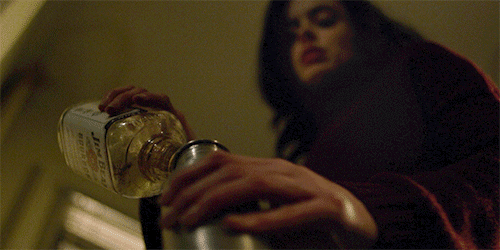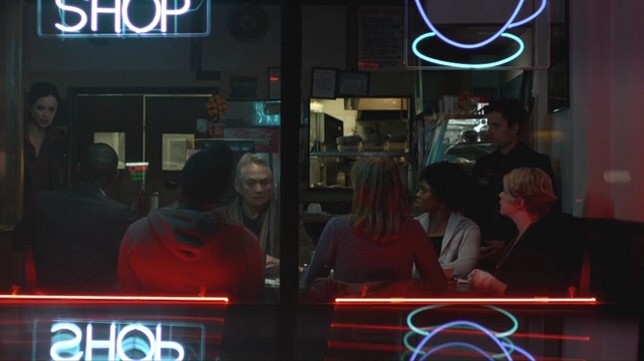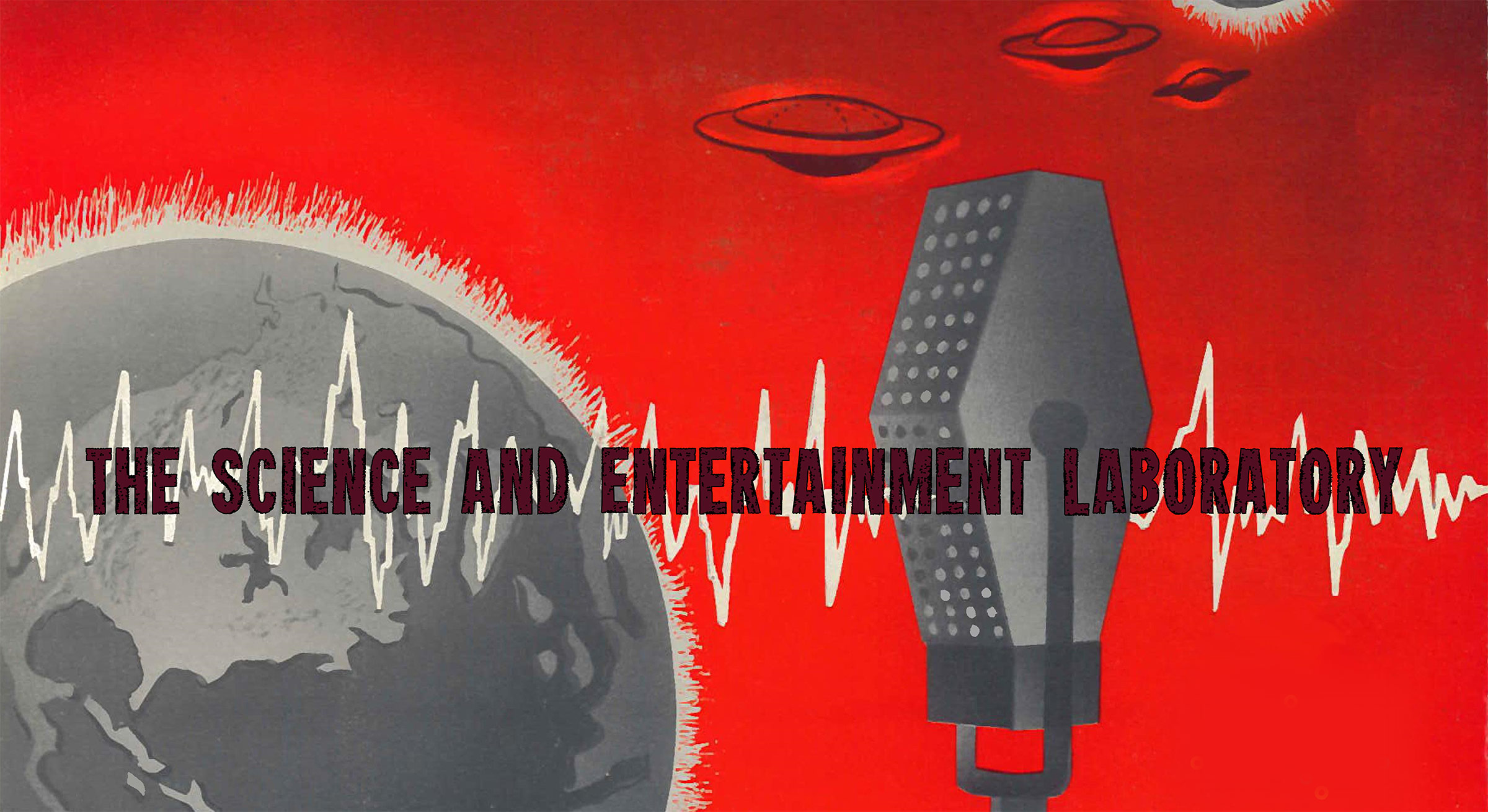This post contains **spoilers** for the Netflix series’ Jessica Jones and Daredevil. Please take a look at my previous post on Daredevil for further discussion of the show.
Only seven months after the successful release of Daredevil, Netflix have given us Jessica Jones. It is part of a series of four shows produced by Netflix – Daredevil, Jessica Jones, Luke Cage, and Iron Fist – that will eventually crossover into a miniseries: The Defenders. Luke Cage will debut in 2016 while Iron Fist is still in pre-production. There are rumours that suggest that the hold-up revolves around the Iron Fist’s mystical/magical powers that are out of step with the gritty realism that has characterised both Daredevil and Jessica Jones. In the Netflix’s Marvel comic book adaptations the superheroes and their powers can be explained by science – medical/scientific experiments (Jones, Cage, Kilgrave, Simpson) and a childhood accident with radioactive toxic waste (Murdoch) – even if the explanations aren’t exactly entirely ‘accurate’. The active incorporation of science allows these small-screen Marvel adaptations to achieve a greater sense of verisimilitude and also tap into contemporary concerns about viruses, medical experimentation (specifically in relation to genetics), and uncontrolled science/scientists, alongside serious responses to addiction, rape, neglect, PTSD, and mental illness.
Jessica Jones is set in Hell’s Kitchen, the same dangerous New York neighbourhood in which Matt Murdoch/Daredevil resides. Referred to as ‘the mean streets of Marvel Netflix’ by Brian Michael Bendis, the co-creator of the source comic Jessica Jones: Alias. Hell’s Kitchen is part of the Marvel Cinematic Universe (MCU), the same fictional universe depicted in The Avengers franchise and specifically the Battle of New York. But the fantastical battles and large-scale world saving antics of figures like Captain America and Iron Man become secondary to the real-world daily struggles of the alcoholics, drugs addicts, and desperate people that occupy Jessica’s narrative universe. The titular character, Jessica Jones (Krysten Ritter), is rebuilding her life after being the victim of the obsessive mind-controlling sociopath Kilgrave (David Tennant), who physically and emotionally abused her. He made her kill on his behalf, and he raped her (the series alludes to instances of rape but as Krysten Ritter remarked: “There is the history of assault, yes, but we don’t depict it. It’s not literally on your screen”, which means it isn’t sensationalised and the consequences of abuse are taken seriously rather than simply ‘mined for melodrama‘). Jessica has given up on being a traditional ‘suit up‘ superhero and she scrapes together a living working as a PI solving the problems of the people left behind after the heroes have moved on to their next alien invasion.
 Netflix’s Marvel series’ have thus far focussed upon street-level heroes and the devastating stories of individuals fighting their own personal demons. Jessica fights, or rather drowns her demons with her addictive coping mechanism: alcohol. (The Guardian posted an excellent article on Jessica Jones as an exploration of rape, addiction and control that I highly recommend). She self-medicates using vast quantities of hard liquor, an addiction that is suggested to have developed in response to the loss of her family (for which she blames herself), and her PTSD (following her mental imprisonment by Kilgrave that results in murder and rape). Her best friend is quite a contrast; former child-star Trish Walker (Rachael Taylor) is shown to have been abused by a controlling mother (who was also her agent) culminating in a particularly traumatic flash-back where a teenage Trish is forced to vomit after eating pizza without her mother’s permission. Considering her difficult, although seemingly privileged childhood (“Highest paid child star in television history? That’s a pretty charmed life.” – Will Simpson), Trish reacts by making sure she can’t be hurt by anyone again. She has had rigorous training in self-defence/hand-to-hand combat and she’s created an impenetrable apartment complete with a safe room. Trish is an anchor for Jessica; she tries to keep her super-surrogate-sister safe, not only from Kilgrave but also from herself.
Netflix’s Marvel series’ have thus far focussed upon street-level heroes and the devastating stories of individuals fighting their own personal demons. Jessica fights, or rather drowns her demons with her addictive coping mechanism: alcohol. (The Guardian posted an excellent article on Jessica Jones as an exploration of rape, addiction and control that I highly recommend). She self-medicates using vast quantities of hard liquor, an addiction that is suggested to have developed in response to the loss of her family (for which she blames herself), and her PTSD (following her mental imprisonment by Kilgrave that results in murder and rape). Her best friend is quite a contrast; former child-star Trish Walker (Rachael Taylor) is shown to have been abused by a controlling mother (who was also her agent) culminating in a particularly traumatic flash-back where a teenage Trish is forced to vomit after eating pizza without her mother’s permission. Considering her difficult, although seemingly privileged childhood (“Highest paid child star in television history? That’s a pretty charmed life.” – Will Simpson), Trish reacts by making sure she can’t be hurt by anyone again. She has had rigorous training in self-defence/hand-to-hand combat and she’s created an impenetrable apartment complete with a safe room. Trish is an anchor for Jessica; she tries to keep her super-surrogate-sister safe, not only from Kilgrave but also from herself.

In both Daredevil and Jessica Jones an abused child grows up to be a villain. Daredevil’s Wilson Fisk (Vincent D’Onofrio) – aka ‘the Kingpin’ – is a softly spoken mafia boss who is a departure from the cartoon villain of the comics. He is the series’ main antagonist but is a developed character with a back-story of a physically and mentally abusive alcoholic father (that a 12-year old Fisk ultimately kills in order to save his mother). It forms a reoccurring nightmare that troubles the character throughout the series, which gives Fisk a vulnerability that underpins his budding romantic relationship with art dealer Vanessa and rationalised motivation for attempting to destroy (or in his logic, protect) Hell’s Kitchen. He wants to tear it down so he can rebuild it into something better (take a look at this Den of Geek post on Fisk as anti-hero/anti-villain). Jessica Jones’ Kilgrave, born Kevin Thompson, suffers at the hands of his seemingly uncaring neuroscientist parents Albert (Michael Siberry) and Louise (Lisa Emery). In unsanctioned experiments at the University of Manchester in 1985 (yes, this is why I had to write this – the mad scientists are from Madchester!), a petrified 10-year old boy is subjected to neurological exams, a fluoroscopy, invasive brain biopsies, and painful cerebrospinal fluid extractions. Kilgrave’s back-story, that is shown through flashbacks and grainy archive footage, makes him a more complex villain but, as with Fisk in Daredevil, it is his choice to use his influence (literally mind-control) for evil.

Science is horrific. But so is Kilgrave. For a moment audiences might feel sympathy for this sociopath as he cowers away from a video of his childhood torture; he truly suffered at the hands of his parents. Even though it is revealed that these experiments were aggressive treatments intended as a cure for a degenerative neural disease, the 10-year old Kilgrave does elicit sympathy, he is an innocent ill child being brutalised by science. By saving Kevin from a degenerative illness the scientists create Kilgrave (perhaps with allusions to the Frankenstein myth – a lab-created monster). The Thompsons unlock his mind and increase his mental capacity – but it is he who chooses to use it malevolently. The series suggests that this was in his nature and that he was destined to be a villain. His ‘evil scientist’ parents (who are presented as misguided and neglectful rather than malicious) did not really ‘create’ Kilgrave – he was there from the beginning, they just unlocked his potential. The show enters into the psychological debate of nature versus nurture and whether Kilgrave inherited his power (he is interested to find out if a fetus could be carrying his abilities) or if his behaviour was learned. Narcissism and a need to have control over other people may have always a part of Kevin/Kilgrave, but his parents’ neglect and abandonment would have compounded it. His parents are not blameless, and they do take some responsibility and pay the ultimate price for their mistakes. This is where Trish becomes a particularly interesting character because she does not fall into the stereotype/cliche that abused children become abusive adults. Trish suffers but she chooses to become stronger by not taking revenge or becoming controlling, despite the fact that her mother is unrepentant. Trish does not use her history of emotional and physical abuse as justification, but instead it is her inspiration for self-improvement.

Initially Kilgrave’s mind-control power appears to be quite straightforward (if you live in a superhero storyworld) – he tells a person what he wants them to do, and they do it. But as Jessica and members of the Kilgrave Support Group explain, for the person under his influence it feels like you are making the decision – he makes you want to. At the beginning of the series Hope Shlottman (Erin Moriarty), a New York University track star from Omaha, Nebraska, kills her parents. As she explains: “I didn’t want to… But I wanted to.” The desire to complete Kilgrave’s order echoes in the mind of his victim, they must complete their task in order to be released. This makes the series’ approach to rape unusually nuanced as it shows rape as coercive rather than violent – and that even without physical force rape causes trauma. Kilgrave’s victims feel shame for their actions as they are haunted by fractured memories of a time when they were not fully in control. Both Hope and Jessica have to come to terms with the fact that their actions were not their own and that the murders they committed were not their fault. Jessica is only able to control her own actions when she recognises that she was a victim, and she becomes immune to Kilgrave. Literally.

Just to add to the complexity of Kilgrave’s version of mind-control: it’s viral. Jessica is literally immune to Kilgrave’s power and she becomes the first person, since 1985, who has been able to resist him. When Kilgrave’s powers first materialised he immediately used them against his parents, for example, in a moment of frustration he forced his mother Louise to burn off the side of her face with an iron. Louise and Albert went on the run to avoid repercussions from the University of Manchester (“they skipped town in ’88 with some grant money”) but mainly to escape their uncontrollable child after at least three years of torture. As Albert explains, the only reason they have lived this long is that they have kept far away from their son. Kilgrave’s mind-control does not come from sound or touch, but a virus – interestingly in the Alias comics Kilgrave (aka “The Purple Man”) controlled his victims with pheromones that were particularly effective on women – this has been removed from the live-action adaptation and purposely been replaced with a different science-based explanation that is equally effective on male victims, and thus powerlessness is not gendered. Throughout much of episode 9 (AKA Sin Bin) Kilgrave is incapacitated – he has been captured and locked in a sealed CDC chamber with a self-contained oxygen supply. He can’t ‘infect’ anyone with his will, and Jessica has the power to electrocute him if needed (she takes a little too much pleasure in her position of control over Kilgrave). Kilgrave’s parents explain that his mind-control is caused by “a virus” that was used “to repair his damaged DNA”, placing Jessica Jones alongside a raft of other science fiction shows/films where a dangerous virus (in this case Kilgrave) is caused in the process of attempting to cure another. For example, in I am Legend the zombie/vampire virus is the result of a failed attempt to cure cancer and those that are immune hold the cure in their blood (as Albert hopes Jessica does), and in the most recent additions to the Planet of the Apes franchise – Rise of the Planet of the Apes and Dawn of the Planet of the Apes – the dramatic increase in ape brain function and the death of the majority of the humans follows an experimental treatment for alzheimer’s. In Jessica Jones mind-control becomes another virus that is the result of scientists trying to do something good (save a child) but failing to fully consider the consequences of playing god.

Jessica Jones is a new addition to a growing number of superhero stories that push for realism. The cartoon campiness of some previous TV show superheroes, for example the implausibly camp Adam West Batman of the 1960s, have not been consummate adaptations of their graphic novel source materials, that are often quite dark and… well, graphic. More recent adaptations – perhaps spurred on by the success of Christopher Nolan’s Batman films – are more closely aligned to the comics and their often explicit adult content. In deconstructing and reimagining the Batman myth Nolan (and co-writers David S. Goyer and Jonathan Nolan) incorporated realism and made the character human (meaning all of his abilities can be rationally explained). Bruce Wayne/Batman’s only superpower is his extreme wealth, which allows him to develop (or purchase) the science and technology that makes him a superhero. Perhaps, this realism and plausibility gives these contemporary adaptations an aura of quality (take a look at this post from the Science and Entertainment Exchange). In Lab Coats in Hollywood David A. Kirby argues that the ‘construction of science’ becomes a strategy for promotion and audience retention as the inclusion of science/realism can be framed as contributing to entertainment value (read: quality). He goes on to say that ‘audiences do not require accuracy for the sake of accuracy. Audiences want realism only if it enhances entertainment value.’ Plausibility also allows media producers to broaden their audience by making the characters more human and therefore accessible (and entertaining) to non-comic reading filmgoers. By grounding Jessica Jones in science and a more easily acceptable version of ‘reality’ the series does not rely on previous knowledge of the Marvel Universe and an acceptance of implausible, often supernatural characters and events.

In the adaptation of Jessica Jones: Alias the ‘alias’ is removed: there are no Lycra suits and secret identities. Jessica is a flawed hero but she owns her mistakes, her abilities, and then with difficulty her heroic successes. Audiences are embracing more human, tortured heroes. For example, this year’s Mad Max: Fury Road (all hail, Furiosa!) offered ambiguous complex heroes with Tom Hardy‘s Max and Charlize Theron’s Imperator Furiosa (the filmmakers chose not to show scenes of Furiosa’s rape/prostitution either, and instead focussed on the consequences). Jessica fits within a range of characters that show that the invincible and escapist superhero is increasingly obsolete. The incorporation of ‘science’ as a method of explaining the characters and their abilities helps to bring Jessica Jones closer to reality, or at least a workable version of it. Superpowers are not supernatural (as with Iron Fist’s magic fists) but rather acquired following often unwanted or unsanctioned scientific intervention. It is revealed that Jessica has been experimented upon by a (no doubt evil) corporation, Kilgrave was the subject of science experiments at the hands of his parents, Jessica’s lover Luke Cage (Mike Colter) has super strength and unbreakable skin due to a failed science experiment, and police officer Will Simpson is part of a government/military science experiment which enhances his strength with drugs (extreme uppers and downers). The scientific explanation for Jessica, Kilgrave, Simpson, and Luke’s super-human powers come relatively late into the series – but its inclusion is not really a surprise considering the recent trend for science-based superhero narratives.
Further reading on Jessica Jones (not necessarily science-related):
- Lili Loofbourow‘s excellent post on ‘Jessica Jones: shattering exploration of rape, addiction and control‘
- discusses female anti-heroes and reception in: ‘Jessica Jones and Netflix’s New Storytelling‘
- Helpful Wired article on the backstory of Jessica Jones: ‘Marvel’s Jessica Jones on Netflix: Everything you need to know‘ (contains ALL the spoilers)
- MashableUK post on: ‘Netflix’s ‘Jessica Jones’ knows how to handle trauma — and the road to recovery‘
- Interesting blog post on JJ‘s progressive portrayal of emotional and neurological trauma: ‘What Jessica Jones Says About Trauma and Mental Illness‘
- Great post from A.V. Club: ‘Marvel’s Jessica Jones is a hard-boiled feminist neo-noir (with superpowers)‘
- TIME article on Jessica Jones as ‘Marvel’s Most Nuanced Heroine‘, which includes this sentence (that I wish I had written): ‘Jones, a comic-book character, is played here by Breaking Bad actress Krysten Ritter as a superheroine whose strengths and whose liabilities are both specifically tied to her status as a woman and freed from the sort of condescension that’s long swirled around Black Widow in the Avengers films.’
Please comment below with any further discussions of the series, I would love to read them.



 Follow
Follow
2 comments for “Jessica Jones: Science, Realism, & Netflix”